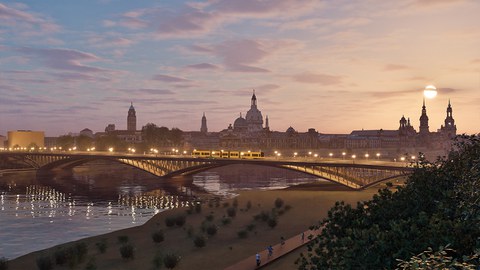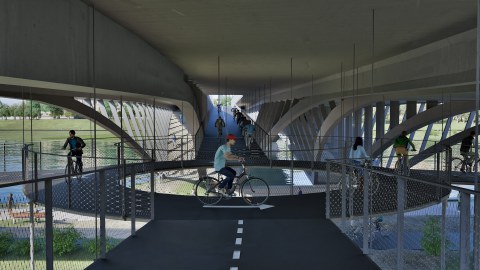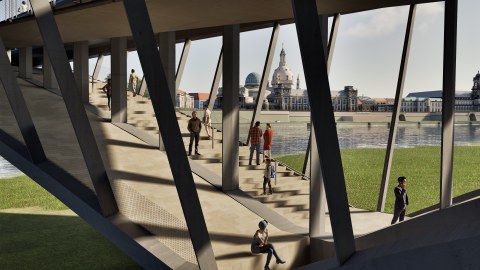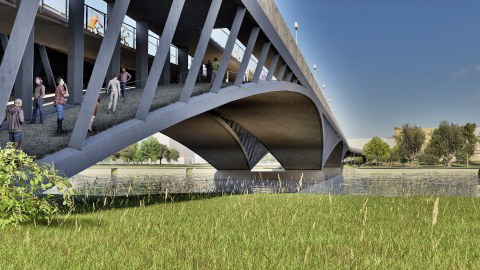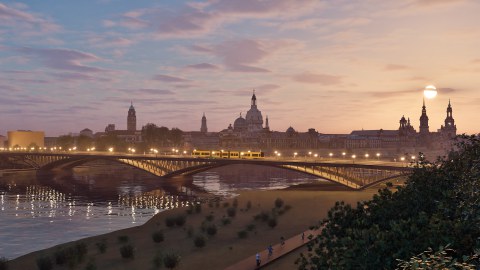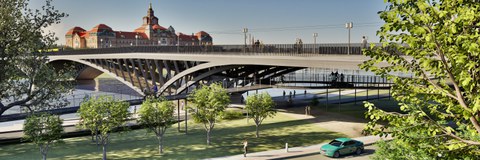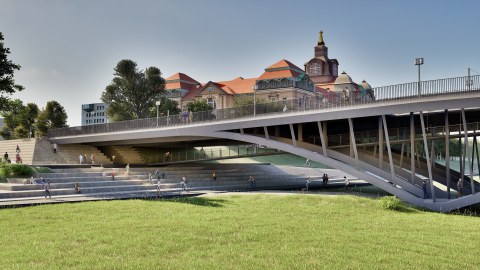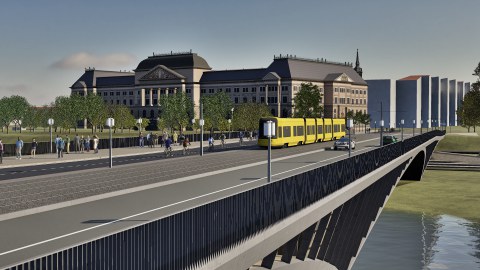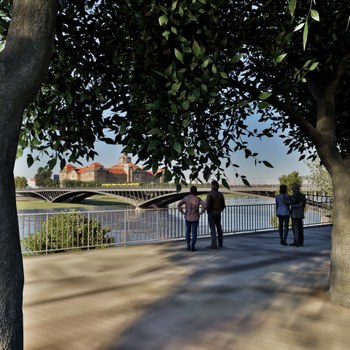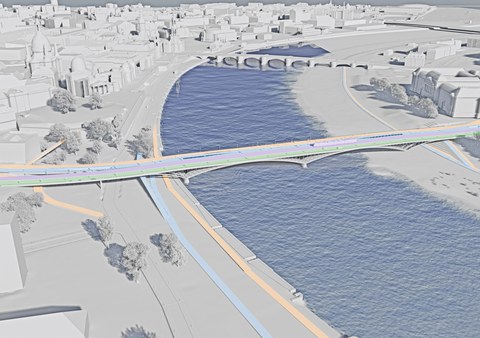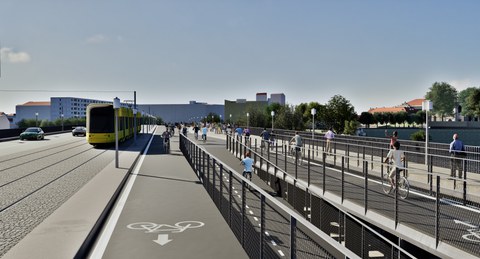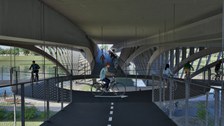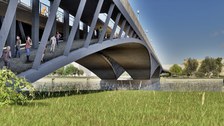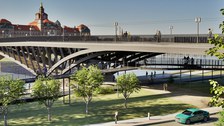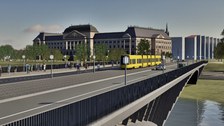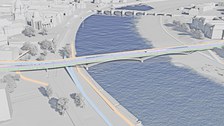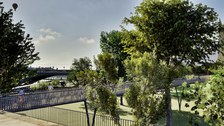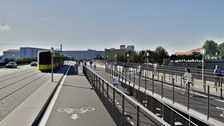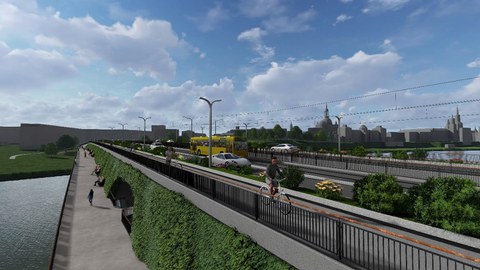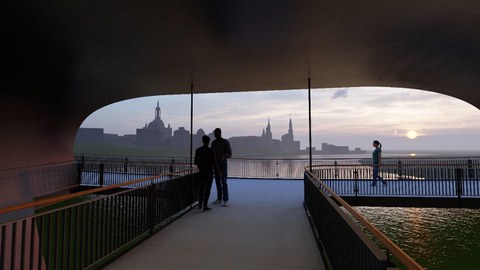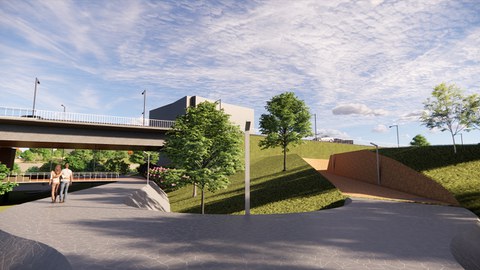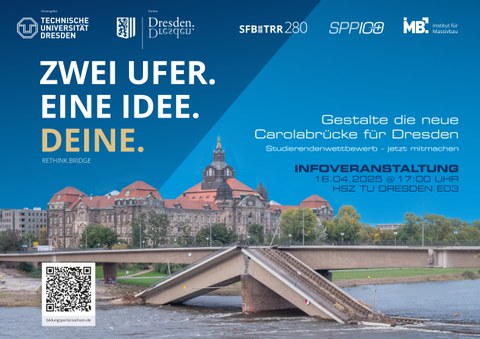Student competition 2025 | RETHINK.Bridge
Table of contents
Winner of the student competition to design a "resource-efficient Elbe crossing using the example of the Carola Bridge" chosen
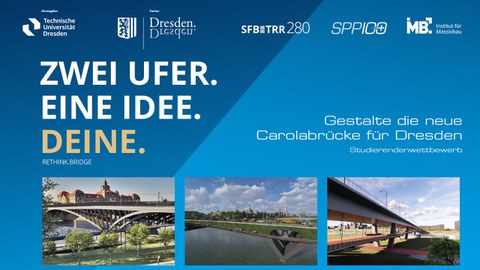
Gewinner des Studierendenwettbewerbs zur Gestaltung einer „ressourceneffizienten Elbquerung am Beispiel der Carolabrücke" gekürt
Under the patronage of the City of Dresden and in cooperation with the TUD Dresden University of Technology, a student competition was held to design a "resource-efficient Elbe crossing using the example of the Carola Bridge". The aim was to develop a design for a bridge that would close the gap that has existed at this central point in the city since September 11, 2024.
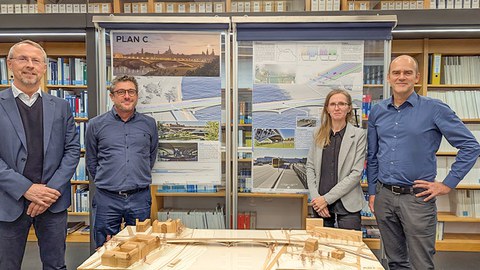
Die Jury vor dem Siegerentwurf v.l.: Professor Richard Stroetmann (TU Dresden), Bart Halaczek, Professorin Yvonne Ciupack (TU Darmstadt), Professor Steffen Marx (TU Dresden).
Particular attention was paid to the central location of the bridge and the diverse traffic flows above and below the Elbe. On Monday, October 6, 2025, an expert jury (consisting of representatives from TU Dresden, TU Darmstadt and industry) selected the winners from a total of twelve entries. Cost specifications were deliberately not set in the competition in order to give the participants the greatest possible creative freedom. The city council's decision to expand the bridge to four lanes was only made during the competition. The strict planning conditions for the actual reconstruction were also not known at the start of the student competition.
"As with the last competition, we once again saw an impressively high quality of submissions," emphasized Steffen Marx, Director of the Institute of Concrete Structures at TU Dresden. "It is pleasing to see how students are developing their ideas for a sustainable Carola Bridge and pursuing creative and sustainable approaches."
First prize was awarded to a design that impresses with its outstanding urban planning and design quality. The bridge creates a high quality of stay for all user groups, guides pedestrians, cyclists and traffic safely across the Elbe and makes the structure itself a tangible experience. With the modern reinterpretation of the arched structure, the building blends harmoniously into the city skyline and the existing image of the Elbe bridges and combines innovation with respect for the building culture. The result is a design that has the potential to become a new landmark in the center of Dresden.
1st place: Plan C
Hans Bolz, Marc Lilienthal, Ferdinand Schulte zu Sodingen, Linus Witzel
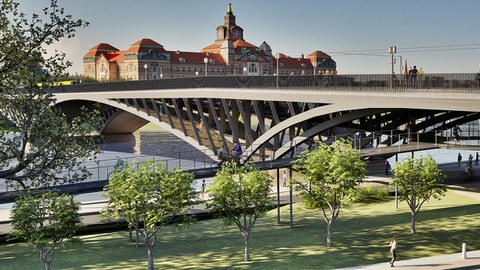
Dieser Entwurf gefällt am besten: "Der Entwurf übersetzt die Brückentradition in Dresden ins Moderne."
Plan C - The winning design impressed the jury with its outstanding urban planning and design quality. The bridge follows the clear idea of creating a high quality of stay for all user groups - be it for pedestrians, cyclists, public transport or motorized traffic - in the middle of Dresden's city center. Thanks to the clever and separate routing above and below the bridge, the Elbe crossing is not only functional, but also becomes an experience. The tourist flows of the Brühl Terraces are integrated in a meaningful way and form a circular route with the building and the Neustädter Elbufer and Augustus Bridge.
The design takes up Dresden's arch bridge tradition and translates it into the modern age. This creates many links to the neighboring bridges and the historic Carola Bridge. The sloping outer surfaces of the arch lend the structure both elegance and lightness, allowing it to blend harmoniously into the Elbe landscape. "The bridge offers something for everyone - a connection that is not only functionally convincing, but also inspiring in terms of design," said the jury. With its bold approach, which deliberately goes beyond the urban requirements, the design demonstrates an attitude that combines innovation with respect for Dresden's building culture. The bridge itself thus becomes a new landmark and makes a lasting impression on Dresden's attractive cityscape.
View poster: https: //datashare.tu-dresden.de/s/WWxSfHLYLJjBHqL
2nd place: Carola Bridge with two levels
Florian Einbock, Florian Felber, Simon Gernlein, Maurice Müller
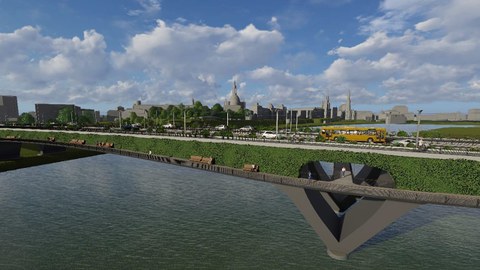
Die Jury lobte den Entwurf: "die Brücke besticht in ihrer Schlichtheit und Klarheit und bietet zugleich eine überraschend hohe Aufenthaltsqualität."
Carola Bridge with two levels - The second-placed design impresses with its clear reduction to the essentials. The focus here is on the idea of creating a functional, well thought-out bridge that impresses with its simplicity and clarity. Despite the restrained approach, the design offers a surprisingly high quality of stay. The stepped footpath and cycle path in particular create places to linger and open up interesting views across the Elbe and into the city. A simple idea succeeds in doing a lot of good - a "city balcony" that impresses with its intensive greenery and contributes to the visual slenderness of the structure. From a structural point of view, the bridge is not perceived as massive from the user's perspective, which emphasizes the elegance and lightness of the bridge. At the same time, it meets the requirements of an appropriate urban bridge that is functional, resource-efficient and sustainable.
The possibility of large-scale prefabrication and a sensible construction method make the design economical and sustainable. The decoupled traffic routes for pedestrians and cyclists, the possibility of changing sides and the flexible usability are particularly positively emphasized: a four-lane system can be guaranteed if necessary, for example when the streetcar is released. The jury recognizes in this design a very appropriate and user-oriented solution that appears calm, clear and well thought out. A bridge that fulfills the requirements of a modern, functional city bridge in an exemplary manner.
3rd place: Carola Bridge with suspended pedestrian and cycle path
Karimi Ishak Fahmy Guirguis, Boril Nestorov, José Luis Arellano Mendoza, Andre Orsoni
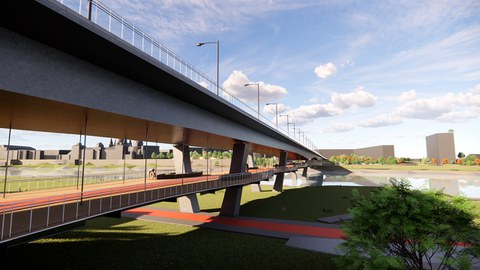
Das Tragwerk des dritten Platzes schafft einen „zusammenhängenden Erlebnisbereich zwischen Brühlschen Terrassen und Neustädter Elbufer."
Carola Bridge with suspended pedestrian and cycle path - the third-placed design impresses with its urban planning idea of creating a new urban space that connects the two banks of the Elbe to form a coherent experience. The bridge is seen not just as a structure, but as an integral part of a circular route that opens up new pathways and enables active use by the urban population. The jury emphasized that this design offers new views and perspectives of the city and opens up new places with a high quality of stay.
The building's orientation towards the existing structure means that it blends naturally into its surroundings, while at the same time confidently defining a new, independent space. The clear decoupling of pedestrian and bicycle traffic, which offers a high degree of comfort and safety, is particularly well received. The suspended footpaths also help to keep the overall width of the bridge to a minimum, resulting in a narrow appearance while creating areas protected from the weather. A connecting, inviting structure that cleverly takes up and continues the connection to the existing network of paths. With its spatial quality and well thought-out design, this design succeeds in linking both sides of the river in a special way.
Contact:
 © Stefan Gröschel
© Stefan Gröschel
Research Associate
NameMr Dipl.-Ing. Jakob Vogt
Send encrypted email via the SecureMail portal (for TUD external users only).
Technische Universität Dresden - Institute of Concrete Structures
Technische Universität Dresden - Institute of Concrete Structures
Visiting address:
BEY Beyer-Bau, Floor -1, Room S 52 George-Bähr-Str. 1
01069 Dresden
RETHINK.bridge: Design of a resource-efficient Elbe crossing using the example of the Carola Bridge Dresden
Preamble
On September 11, 2024, an unexpected partial collapse of the Carola Bridge occurred in Dresden, causing an approximately 100-meter-long segment of the bridge c to fall into the Elbe. Fortunately, there were no injuries, but this event caused considerable disruption for the people of Dresden. The Carola Bridge was an outstanding engineering structure and one of Dresden's central Elbe crossings and played a crucial role in the city's transportation network. It connected the Old Town with the New Town and was used by thousands of people every day, including motor vehicles, pedestrians, cyclists and public transport such as streetcars. Its strategically favorable location enabled efficient traffic routing and contributed significantly to relieving the burden on the neighboring bridges. Since its collapse, alternative routes have inevitably been used, leading to increased traffic volumes and delays on the other Elbe crossings.
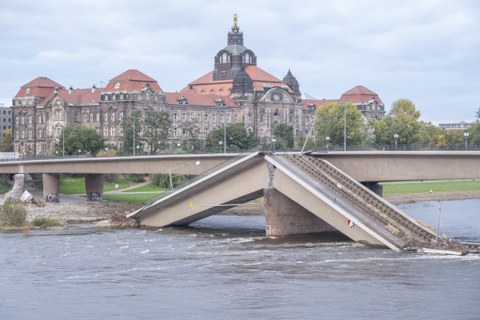
Die teilweise eingestürzte Carolabrücke Dresden im Oktober 2024
Investigations into the cause of the collapse revealed that the successive failure of tendons due to hydrogen-induced stress corrosion cracking was the main cause. The damage process was initiated during the construction period from the late 1960s to 1971 and went unnoticed for decades. Due to the extensive and continued damage, it is not possible to preserve bridge sections a and b, which is why complete demolition of the bridge is unavoidable. With the decision to completely demolish the Carola Bridge, the planning of a new Elbe crossing must also begin.
Aim of the competition
A competition to redesign the Carola Bridge was held back in 1964. The results were publicly exhibited and judged. Around 250 students also gave their opinions on the bridge designs. This competition encouraged innovative approaches and contributed significantly to the design of the structure that was later realized.
In keeping with this tradition, the students themselves will now have the opportunity to contribute their creative and visionary ideas for the new Carola Bridge. We are looking for bold, technically sophisticated, resource-efficient and functional designs that respect both the significance of the location and the history of the crossing while integrating innovative construction methods and technologies. The new bridge should not only meet current and future traffic requirements, but also enrich Dresden's skyline as an architectural landmark. This competition offers a unique opportunity to make a formative contribution to the design of Dresden's cityscape and to continue the tradition of outstanding engineering.
Theme | Task
The task is to design a new Elbe crossing on the site of the collapsed Carola Bridge. The bridge is to connect the two districts of Neustadt and Altstadt for road, bicycle and pedestrian traffic and provide tracks for the streetcars of the Dresden public transport company.
The exact route of the structure can be chosen independently within the boundaries of the existing buildings and taking into account the planned and existing infrastructure. The entire design area extends from Rathenau- to Carolaplatz. Attention must be paid to a sensible connection to the existing network of paths and a suitable integration of the Elbe cycle path running along both sides of the Elbe. The bridge can serve as an impulse generator for the further development of the traffic axis St. Petersburger Straße and Albertstraße-Carolaplatz. Particular attention is drawn to the careful inclusion of the supra-regionally significant surroundings, especially the old town.
The focus of the task lies in the development of a constructively interesting and sensible design. The supporting structure should be designed to be efficient and resource-saving. The choice of materials and the construction method are open, whereby material-appropriate and realistic design approaches are assumed. In addition, high demands must be placed on the construction process, as the navigability of the Elbe as an important international waterway must be guaranteed.
The functional division of the bridge for the individual types of traffic or a possible combination is to be worked out freely. The usable widths to be applied can be sensibly and justifiably adjusted as part of the planning process. Existing development studies by the city of Dresden on the design of the Königsufer and St. Petersburger Straße can be taken into account. The structure and the transition to the banks of the Elbe must be designed to be barrier-free. The bank area below the structure may be freely planned. The entire structure must be provided with adequate and attractive lighting.
The height of the danger zone to be kept clear above the Elbe is 7.875 m and applies to a width of 196 m. This height must be guaranteed. The main span with a length of 120 m should preferably be retained. The necessary substructures are to be erected primarily on the foundations of the previous structures.

Gefahrenbereich und freizuhaltendes Lichtraumprofil der Elbe, im Hintergrund Carolabrücke
The following features are given special consideration by the jury and should therefore be urgently taken into account in the design:
- High material efficiency of the supporting structure with sufficient robustness (principles of "form follows force" and "form follows function")
- Ecological use of resources
- Urban integration into the surroundings
- Height classification in the terrain
- Sensible external development
- Sustainable operation of the bridge
- Design of the bridge
- Construction process taking into account the interests of shipping traffic
Competition documents
In addition to the brief, the following documents will be provided by the competition organizers:
- Template for a declaration of eligibility and copyright (.pdf)
- Photos of the surroundings (.jpg)
- Site plan 1:2,500 - Thematic city map of Dresden (.pdf)
- Site plan 1:5,000 - Themed city map of Dresden (.pdf)
- DTM model of the surrounding area (.dxf)
- Cross-section of the prestressed concrete Carola Bridge (1966-1971) (.pdf)
The documents are available for download at the following link:
- Opal(LINK)
In addition, a digital terrain model is available via a WMS interface at the following link. The WMS data can be displayed using GIS software.
- Opal(LINK)
Dates
The student competition will be announced for the summer semester 2025. The competition documents will be made available to students from 16.04.2025 via Opal(LINK). The following dates are part of the competition:
|
16.04.2025 |
Information event and provision of the brief |
|
Announcement via Opal |
Possibility of a site visit (presence) |
|
29.08.2025 |
Submission of the competition entries |
|
September 2025 |
Jury meeting in Dresden |
|
October 2025 |
Award ceremony |
Further information on consultation opportunities, site visit, jury meeting and award ceremony will be announced in good time before the respective event via Opal(LINK).
Contact us
 © Stefan Gröschel
© Stefan Gröschel
Research Associate
NameMr Dipl.-Ing. Jakob Vogt
Send encrypted email via the SecureMail portal (for TUD external users only).
Technische Universität Dresden - Institute of Concrete Structures
Technische Universität Dresden - Institute of Concrete Structures
Visiting address:
BEY Beyer-Bau, Floor -1, Room S 52 George-Bähr-Str. 1
01069 Dresden

